Coupling Coordination Development of Urbanization and Ecological Environment in the Urban Agglomeration on the Northern Slope of the Tianshan Mountains, China
Abstract
1. Introduction
2. Materials and Methods
2.1. Study Area
2.2. Data Resources and Preprocessing
2.3. Methods
2.3.1. New Remote Sensing Ecological Index
- (1)
- Normalized vegetation index (NDVI)
- (2)
- Wetness index (WET)
- (3)
- Land surface temperature (LST)
- (4)
- Normalized differential built-up and bare soil index (NDBSI)
- (5)
- Difference index (DI)
2.3.2. Estimation of Compounded Nighttime Light Index (CNLI)
2.3.3. Coupling Coordination Degree Model (CCDM)
3. Results and Analysis
3.1. RSEInew Model Testing
3.2. Spatial and Temporal Pattern Analysis of RSEInew
3.2.1. Estimation of RSEInew
3.2.2. Spatial Distribution Characteristics of RSEInew
3.2.3. Seasonal Analysis of RSEInew
3.3. Coupling Relationship between Urbanization and Eco-Environment
3.3.1. Change in the Mean RSEInew Value in the Main City of UANSTM
3.3.2. Extraction of Urbanization Features in UANSTM
3.3.3. Coupling Coordination Degree Analysis of Different Cities
4. Discussion
4.1. Suitability of RSEInew
4.2. Cause Analysis of RSEInew Index and Coupling Coordination Degree
5. Conclusions
Author Contributions
Funding
Institutional Review Board Statement
Informed Consent Statement
Data Availability Statement
Acknowledgments
Conflicts of Interest
References
- Padhee, S.K.; Dutta, S. Spatio-temporal reconstruction of MODIS NDVI by regional land surface phenology and harmonic analysis of time-series. GISci. Remote Sens. 2019, 56, 1261–1288. [Google Scholar] [CrossRef]
- Chen, J.; Gao, J.; Chen, W. Urban land expansion and the transitional mechanisms in Nanjing, China. Habitat Int. 2016, 53, 274–283. [Google Scholar] [CrossRef]
- Sowińska-Świerkosz, B. Application of surrogate measures of ecological quality assessment: The introduction of the Indicator of Ecological Landscape Quality (IELQ). Ecol. Indic. 2017, 73, 224–234. [Google Scholar] [CrossRef]
- Luo, Y.; Sun, W.; Yang, K.; Zhao, L. China urbanization process induced vegetation degradation and improvement in recent 20 years. Cities 2021, 114, 103207. [Google Scholar] [CrossRef]
- Wang, S.; Ma, H.; Zhao, Y. Exploring the relationship between urbanization and the eco-environment-a case study of Beijing-Tianjin-Hebei region. Ecol. Indic. 2014, 45, 171–183. [Google Scholar] [CrossRef]
- Lee, L.S.H.; Zhang, H.; Jim, C.Y. Serviceable tree volume: An alternative tool to assess ecosystem services provided by ornamental trees in urban forests. Urban For. Urban Green. 2021, 59, 127003. [Google Scholar] [CrossRef]
- Qureshi, S.; Alavipanah, S.K.; Konyushkova, M.; Mijani, N.; Fathololomi, S.; Firozjaei, M.K.; Homaee, M.; Hamzeh, S.; Kakroodi, A.A. A remotely sensed assessment of surface ecological change over the Gomishan Wetland, Iran. Remote Sens. 2020, 12, 2989. [Google Scholar] [CrossRef]
- Tang, P.; Huang, J.; Zhou, H.; Fang, C.; Zhan, Y.; Huang, W. Local and telecoupling coordination degree model of urbanization and the eco-environment based on RS and GIS: A case study in the Wuhan urban agglomeration. Sustain. Cities Soc. 2021, 75, 103405. [Google Scholar] [CrossRef]
- Hazbavi, Z.; Sadeghi, S.H.; Gholamalifard, M.; Davudirad, A.A. Watershed health assessment using the pressure–state–response (PSR) framework. Land Degrad. Dev. 2020, 31, 3–19. [Google Scholar] [CrossRef]
- Novoa, J.; Chokmani, K.; Lhissou, R. A novel index for assessment of riparian strip efficiency in agricultural landscapes using high spatial resolution satellite imagery. Sci. Total Environ. 2018, 644, 1439–1451. [Google Scholar] [CrossRef]
- Tang, W.; Zhou, T.; Sun, J.; Li, W. Accelerated urban expansion in lhasa city and the implications for sustainable development in a Plateau City. Sustainability 2017, 9, 1499. [Google Scholar] [CrossRef]
- Ochoa-Gaona, S.; Kampichler, C.; De Jong, B.H.J.; Hernández, S.; Geissen, V.; Huerta, E. A multi-criterion index for the evaluation of local tropical forest conditions in Mexico. For. Ecol. Manag. 2010, 260, 618–627. [Google Scholar] [CrossRef]
- Zhang, R.G.; Mo, X.G.; Liu, Z.H. The trend and principal influence factors of evapotranspiration in Hutuo River Basin during last 50 years. Sci. Geogr. Sin. 2012, 32, 628–634. [Google Scholar]
- Cui, Q.Y.; Pan, Y.; Yang, X. Beijing plain area of remote sensing images based on Landsat 8 impermeable layer coverage estimates. J. Cap. Norm. Univ. (Nat. Sci. Ed.) 2015, 36, 89–92. [Google Scholar]
- Xu, H.Q. A remote sensing urban ecological index and its application. Acta Ecol. Sin. 2013, 33, 7853–7862. [Google Scholar]
- Liao, W.; Jiang, W. Evaluation of the spatiotemporal variations in the eco-environmental quality in China based on the remote sensing ecological index. Remote Sens. 2020, 12, 2462. [Google Scholar] [CrossRef]
- Huang, H.; Chen, W.; Zhang, Y.; Qiao, L.; Du, Y. Analysis of ecological quality in Lhasa Metropolitan Area during 1990–2017 based on remote sensing and Google Earth Engine platform. J. Geogr. Sci. 2021, 31, 265–280. [Google Scholar] [CrossRef]
- Zhu, D.Y.; Chen, T.; Niu, R.Q.; Zhen, N. Analyzing the ecological environment of mining area by using moving window remote sensing ecological index. Wuhan Daxue Xuebao Xinxi Kexueban 2021, 46, 341–347. [Google Scholar]
- Wang, S.D.; Si, J.J.; Wang, Y. Study on Evaluation of Ecological Environment Quality and Temporal-Spatial Evolution of Danjiang River Basin (Henan Section). Pol. J. Environ. Stud. 2021, 30, 2353–2367. [Google Scholar] [CrossRef]
- Stirnberg, R.; Cermak, J.; Andersen, H. An analysis of factors influencing the relationship between satellite-derived AOD and ground-level PM10. Remote Sens. 2018, 10, 1353. [Google Scholar] [CrossRef]
- Yao, L.; Li, X.; Li, Q.; Wang, J. Temporal and spatial changes in coupling and coordinating degree of new urbanization and ecological-environmental stress in China. Sustainability 2019, 11, 1171. [Google Scholar] [CrossRef]
- Cai, B.; Shao, Z.F.; Fang, S.H.; Huang, X.; Huq, M.E.; Tang, Y.; Li, Y.; Zhuang, Q. Finer-scale spatiotemporal coupling coordination model between socioeconomic activity and eco-environment: A case study of Beijing, China. Ecol. Indic. 2021, 131, 108165. [Google Scholar] [CrossRef]
- Chen, X.H.; Zhou, H.H. Research hotspots and prospects of urbanization and ecological environment relationship based on visual knowledge mapping. Prog. Geogr. 2018, 37, 1171–1185. [Google Scholar]
- Fang, N.; Zhang, Q.; Yang, D.X. Spatial-temporal evolution and coupling coordination between ecological civilization construction and urbanization in Hunan Province. Areal Res. Dev. 2020, 39, 59–64. [Google Scholar]
- Liang, L.W.; Wang, Z.B.; Fang, C.L.; Sun, Z. Spatiotemporal differentiation and coordinated development pattern of urbanization and the ecological environment of the Beijing-Tianjin-Hebei urban agglomeration. Acta Ecol. Sin. 2019, 39, 1212–1225. [Google Scholar]
- Chu, N.C.; Wu, X.L.; Zhang, P.Y.; Li, H.; Yang, Q.F. Spatiotemporal evolution characteristics of coordinated development of urbanization and ecological environment in eastern Russia. Acta Ecol. Sin. 2021, 41, 9717–9728. [Google Scholar]
- Tao, C.J.; Xia, A.T.; Li, D.P. Research on the coupling coordination development of urbanization and ecological environment in Maanshan City. Ecol. Sci. 2021, 40, 129–138. [Google Scholar]
- Zhang, L.F.; Fang, C.L.; Gao, Q. Spatial and temporal expansion of urban landscape and multi-scene simulation of urban agglomeration in northern slope of Tianshan Mountains. Acta Ecol. Sin. 2021, 41, 1267–1279. [Google Scholar]
- Fang, C.L. Strategic thinking and spatial layout for the sustainable development of urban agglomeration in northern slope of Tianshan Mountains. Arid Land Geogr. 2019, 42, 1–11. [Google Scholar]
- Xu, H. A new index for delineating built-up land features in satellite imagery. Int. J. Remote Sens. 2008, 29, 4269–4276. [Google Scholar] [CrossRef]
- Zha, Y.; Gao, J.; Jiang, J.; Lu, H.; Huang, J. Normalized difference haze index: A new spectral index for monitoring urban air pollution. Int. J. Remote Sens. 2012, 33, 309–321. [Google Scholar] [CrossRef]
- Chen, Z.; Yu, B.L.; Yang, C.S.; Zhou, Y.Y.; Yao, S.J.; Qian, X.J.; Wang, C.X.; Wu, B.; Wu, J.P. An extended time series (2000–2018) of global NPP-VIIRS-like nighttime light data from a cross-sensor calibration. Earth Syst. Sci. Data 2021, 13, 889–906. [Google Scholar] [CrossRef]
- Wan, H.L.; Huo, F.; Niu, Y.; Zhang, W.; Zhang, Q. Dynamic monitoring and analysis of ecological environment change in Cangzhou city based on RSEI model considering PM2. 5 concentration. Prog. Geophys. 2021, 36, 953–960. [Google Scholar]
- Feng, H.Y.; Feng, Z.K.; Feng, H.X. One new method of PM2.5 concentration inversion based on difference index. Spectrosc. Spectr. Anal. 2018, 38, 3012. [Google Scholar]
- Feng, H.X.; Feng, H.Y.; Yang, L.C.; Wang, Q.; Meng, X.L.; Wang, Y.F. A remote sensing monitoring method of urban air quality based on Landsat 8. Huanjing Wuran Yu Fangzhi 2021, 43, 79–83+90. [Google Scholar]
- Yan, L.; He, R.; Kašanin-Grubin, M.; Luo, G.; Peng, H.; Qiu, J. The Dynamic Change of Vegetation Cover and Associated Driving Forces in Nanxiong Basin, China. Sustainability 2017, 9, 443. [Google Scholar] [CrossRef]
- Jin, S.; Sader, S.A. Comparison of time series tasseled cap wetness and the normalized difference moisture index in detecting forest disturbances. Remote Sens. Environ. 2005, 94, 364–372. [Google Scholar] [CrossRef]
- Baig, M.H.A.; Zhang, L.; Shuai, T.; Tong, Q. Derivation of a tasselled cap transformation based on Landsat 8 at-satellite reflectance. Remote Sens. Lett. 2014, 5, 423–431. [Google Scholar] [CrossRef]
- Xu, H. Assessment of ecological change in soil loss area using remote sensing technology. Trans. Chin. Soc. Agric. Eng. 2013, 29, 91–97. [Google Scholar]
- Liu, G.; Zhang, Q.; Li, G.; Doronzo, D.M. Response of land cover types to land surface temperature derived from Landsat-5 TM in Nanjing Metropolitan Region, China. Environ. Earth. Sci. 2016, 75, 1386. [Google Scholar] [CrossRef]
- Yu, X.; Guo, X.; Wu, Z. Land surface temperature retrieval from Landsat 8 TIRS—Comparison between radiative transfer equation-based method, split window algorithm and single channel method. Remote Sens. 2014, 6, 9829–9852. [Google Scholar] [CrossRef]
- Yang, J.; Duan, S.B.; Zhang, X.; Wu, P.; Huang, C.; Leng, P.; Gao, M. Evaluation of seven atmospheric profiles from reanalysis and satellite-derived products: Implication for single-channel land surface temperature retrieval. Remote Sens. 2020, 12, 791. [Google Scholar] [CrossRef]
- Gao, W.; Zhang, S.; Rao, X.; Lin, X.; Li, R. Landsat TM/OLI-Based Ecological and Environmental Quality Survey of Yellow River Basin, Inner Mongolia Section. Remote Sens. 2021, 13, 4477. [Google Scholar] [CrossRef]
- Hu, X.; Xu, H. A new remote sensing index for assessing the spatial heterogeneity in urban ecological quality: A case from Fuzhou City, China. Ecol. Indic. 2018, 89, 11–21. [Google Scholar] [CrossRef]
- Rikimaru, A.; Roy, P.S.; Miyatake, S. Tropical forest cover density mapping. Trop. Ecol. 2002, 4, 39–47. [Google Scholar]
- Essa, W.; Verbeiren, B.; van der Kwast, J.; Van de Voorde, T.; Batelaan, O. Evaluation of the DisTrad thermal sharpening methodology for urban areas. Int. J. Appl. Earth Obs. 2012, 19, 163–172. [Google Scholar] [CrossRef]
- Awad, M.; Aldaood, A.; Alkiki, I. Development of a Compressibility Prediction Model Based on Soil Index Properties and Area Under/Bounded by Consolidation and Rebound Curves. Geotech. Geol. Eng. 2022, 40, 4787–4807. [Google Scholar] [CrossRef]
- Wang, Y.H.; Xiao, Y. Inversion and Spatial-temporal distribution analysis on PM5.0 inhalable particulate in Beijing. Environ. Sci. 2014, 35, 428–435. [Google Scholar]
- He, J.L.; Zhang, S.Y.; Li, J.; Zha, Y. Particulate matter indices derived from MODIS data for dictating urban air pollution. Remote Sens. Land Resour. 2016, 28, 126–131. [Google Scholar]
- Xu, H.; Wang, M.; Shi, T.; Guan, H.; Fang, C.; Lin, Z. Prediction of ecological effects of potential population and impervious surface increases using a remote sensing based ecological index (RSEI). Ecol. Indic. 2018, 93, 730–740. [Google Scholar] [CrossRef]
- Wang, B.; Chen, L.; Li, L.; Xie, H.; Zhang, Y. Ecological response to land use change: A case study from the Chaohu lake basin, China. Bulg. Chem. Commun. 2017, 49, 200–206. [Google Scholar]
- Boori, M.S.; Choudhary, K.; Paringer, R.; Kupriyanov, A. Spatiotemporal ecological vulnerability analysis with statistical correlation based on satellite remote sensing in Samara, Russia. J. Environ. Manag. 2021, 285, 112138. [Google Scholar] [CrossRef] [PubMed]
- Yuan, B.D.; Fu, L.; Zou, Y.A.; Zhang, S.Q.; Chen, X.S.; Li, F.; Deng, Z.M.; Xie, Y.H. Spatiotemporal change detection of ecological quality and the associated affecting factors in Dongting Lake Basin, based on RSEI. J. Clean. Prod. 2021, 302, 126995. [Google Scholar] [CrossRef]
- Zhang, T.; Yang, R.; Yang, Y.; Li, L.; Chen, L. Assessing the Urban Eco-Environmental Quality by the Remote-Sensing Ecological Index: Application to Tianjin, North China. ISPRS Int. J. Geo-Inf. 2021, 10, 475. [Google Scholar] [CrossRef]
- Zheng, Z.H.; Wu, Z.; Chen, Y.B.; Yang, Z.W.; Marinello, F. Analyzing the ecological environment and urbanization characteristics of the Yangtze River Delta Urban Agglomeration based on Google Earth Engine. Acta Ecol. Sin. 2021, 41, 717–729. [Google Scholar]
- Zhuo, L.; Shi, P.; Chen, J. Application of compound night light index derived from DMSP/OLS data to urbanization analysis in China in the 1990s. Acta Geogr. Sin. 2003, 58, 893–902. [Google Scholar]
- Liu, W.; Jiao, F.; Ren, L.; Xu, X.; Wang, J.; Wang, X. Coupling coordination relationship between urbanization and atmospheric environment security in Jinan City. J. Clean. Prod. 2018, 204, 1–11. [Google Scholar] [CrossRef]
- Liu, H.; Huang, B.; Yang, C. Assessing the coordination between economic growth and urban climate change in China from 2000 to 2015. Sci. Total Environ. 2020, 732, 139283. [Google Scholar] [CrossRef]
- Shen, L.; Huang, Y.; Huang, Z.; Lou, Y.; Ye, G.; Wong, S.W. Improved coupling analysis on the coordination between socio-economy and carbon emission. Ecol. Indic. 2018, 94, 357–366. [Google Scholar] [CrossRef]
- Hui, D.Y.; Guo, X. The measurement of the coordinated development level of economy resources environment in western regions. Stat. Decis. 2019, 11, 124–128. [Google Scholar]
- Ruili, G.; Linlin, W. Evaluation of Coordinated Development of Urbanization and Ecological Environment in the Efficient Ecological Economic Zone of the Yellow River Delta. Meteorol. Environ. Res. 2018, 9, 47–51. [Google Scholar]
- Ariken, M.; Zhang, F.; Liu, K.; Fang, C.; Kung, H.T. Coupling coordination analysis of urbanization and eco-environment in Yanqi Basin based on multi-source remote sensing data. Ecol. Indic. 2020, 114, 106331. [Google Scholar] [CrossRef]
- Zheng, Z.; Wu, Z.; Chen, Y.; Yang, Z.; Marinello, F. Exploration of eco-environment and urbanization changes in coastal zones: A case study in China over the past 20 years. Ecol. Indic. 2020, 119, 106847. [Google Scholar] [CrossRef]
- Meng, D.; Liu, L.; Gong, H.; Li, X.; Jiang, B. Coupling and coordination relationships between urbanization and ecological environment along the Beijing-Hangzhou Grand Canal. Remote Sens. Land Resour. 2021, 33, 162–172. [Google Scholar]
- Yang, L. Estimating PM2.5 concentrations in eastern coastal area of China using a two-stage random forest model. Remote Sens. Land Resour. 2020, 32, 137–144. [Google Scholar]
- Wan, H.L.; Wang, F.C.; Zhang, W.; Bao, Y.L.; Zhang, L.J.; Zhang, H.; Li, Q. Analysis of land use change driven by the construction of the Grand Canal cultural belt and its ecological effects: Taking Cangzhou section as a case. Prog. Geophys. 2022, 37, 1863–1874. [Google Scholar]
- Chen, Y.; Cheng, X.; Wang, J.L. Analysis of temporal and spatial dynamic changes of farmland in north slope economic zone of Tianshan Mountain from 1990 to 2020. J. Shihezi Univ. (Nat. Sci.) 2022, 40, 223–230. [Google Scholar]


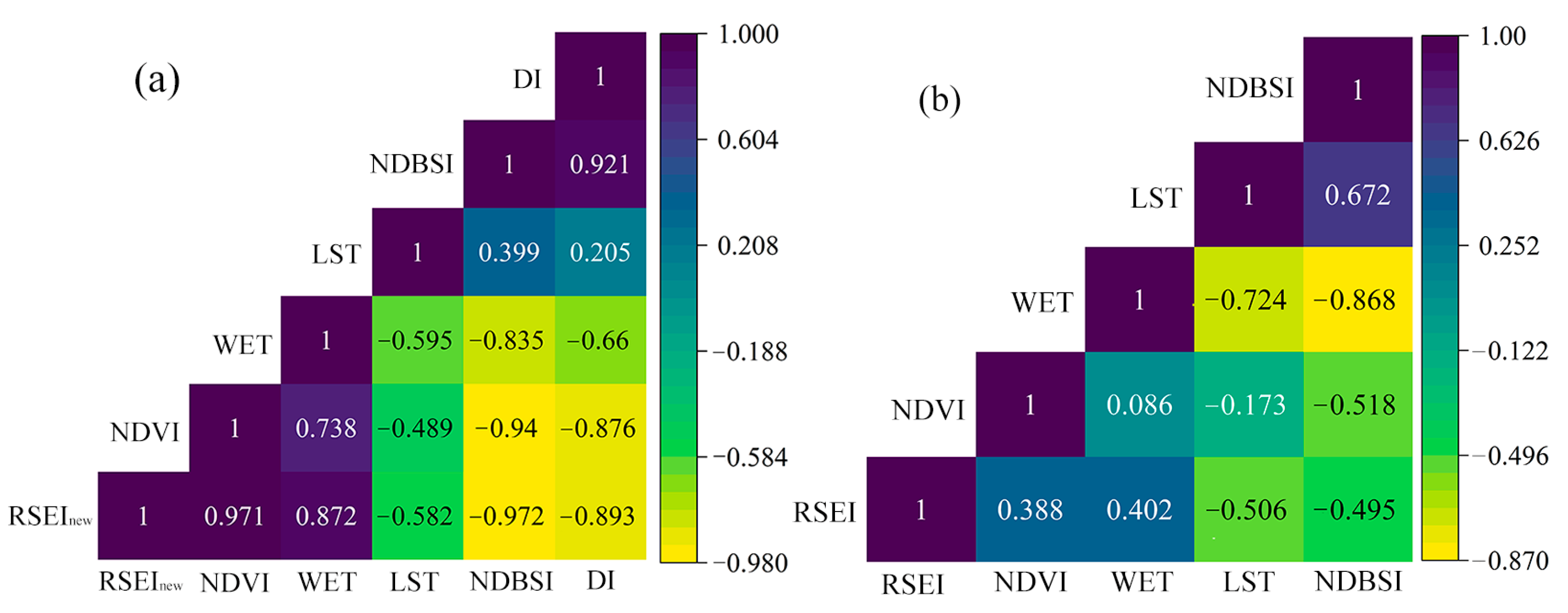

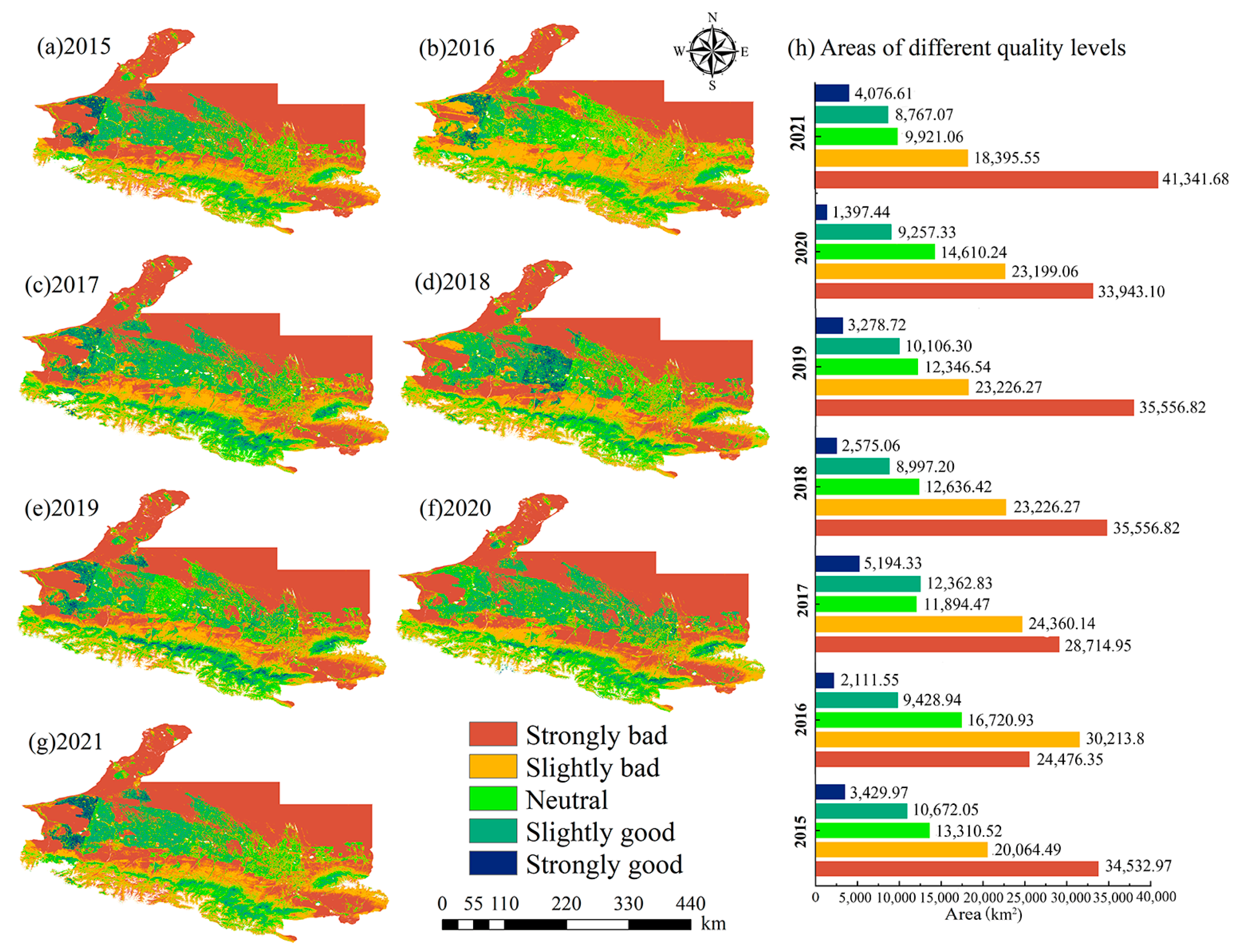

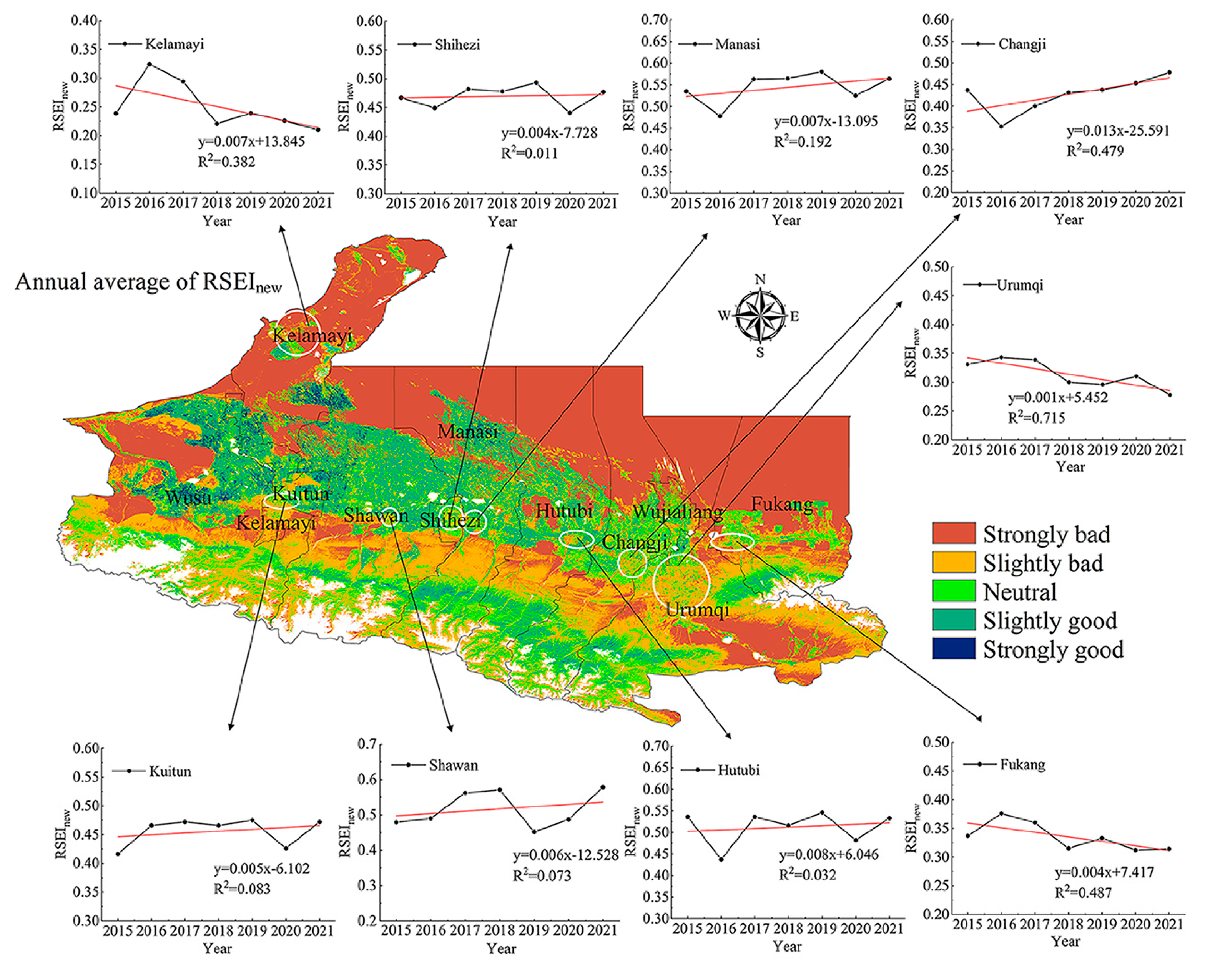
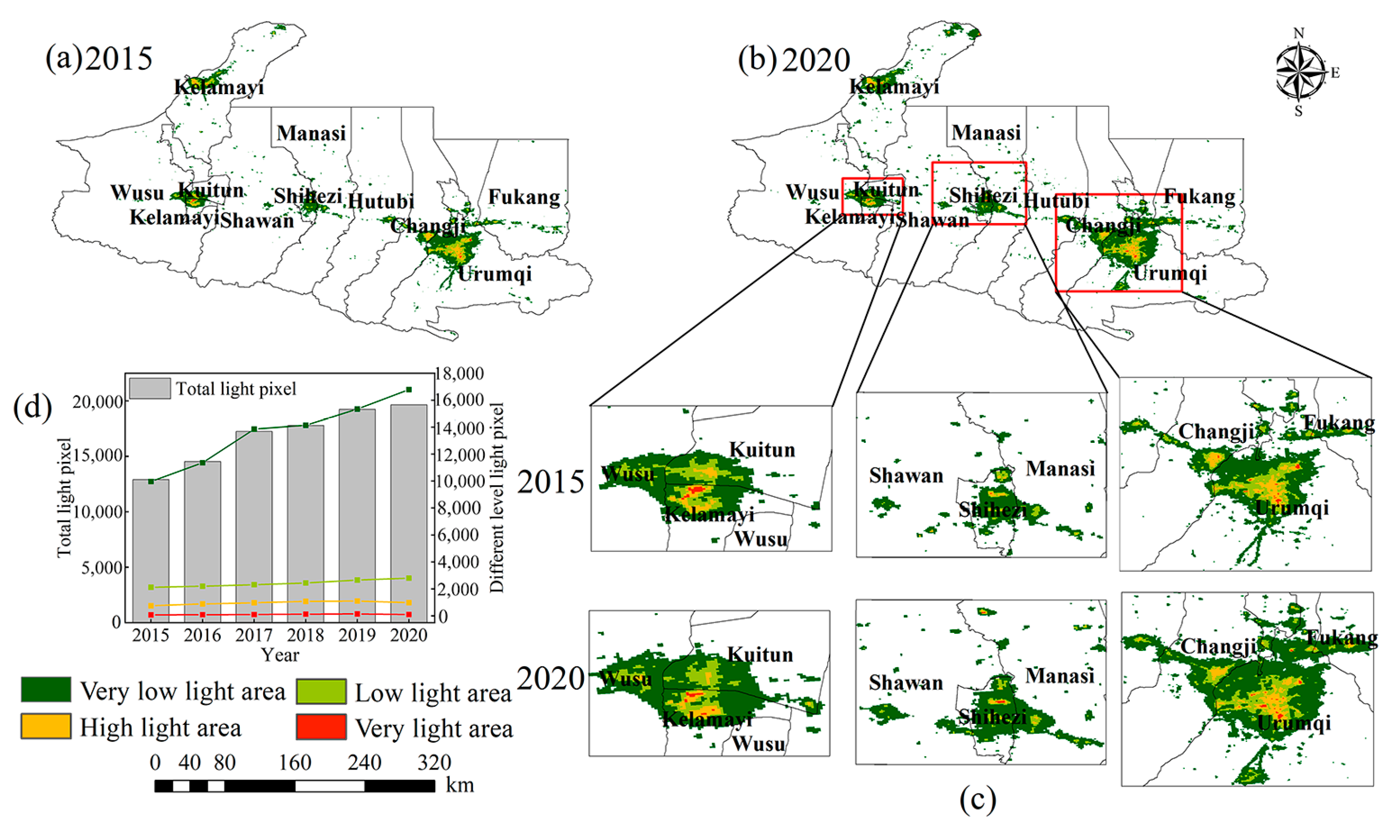
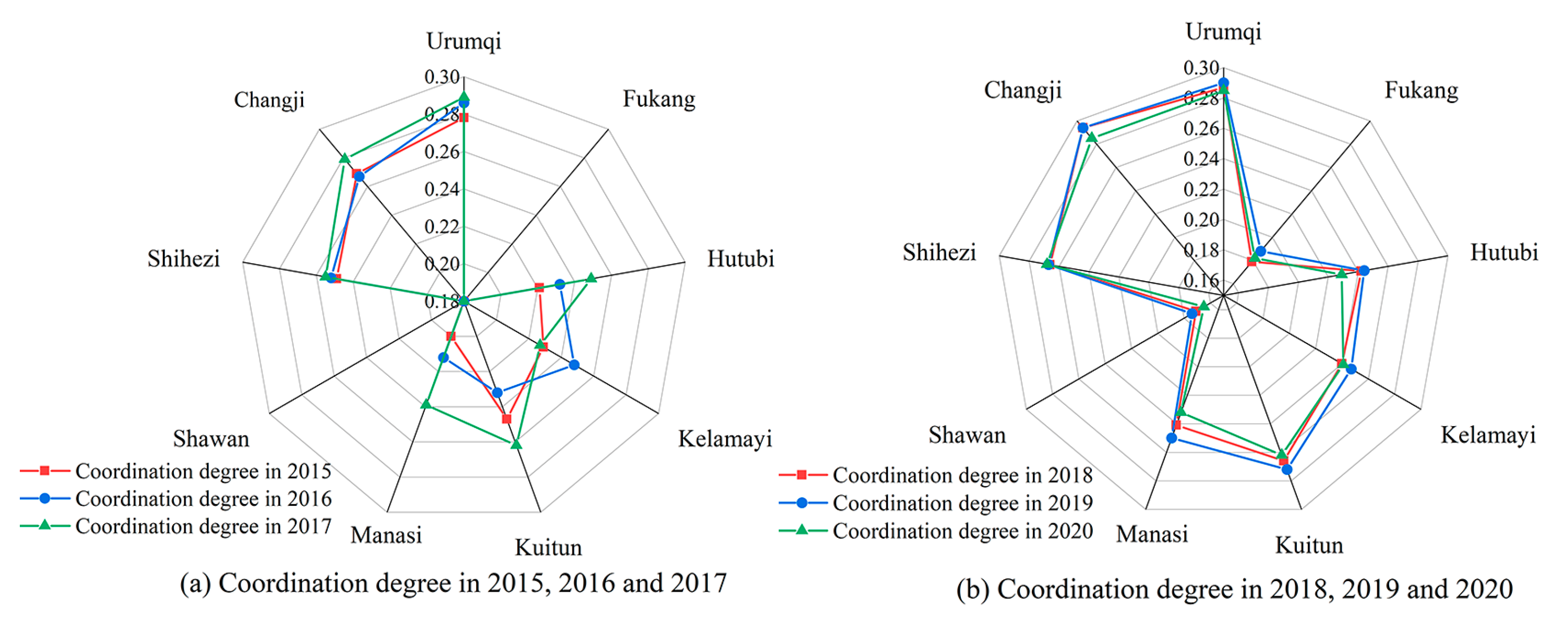
| Data | Data Attribute | Source | Function |
|---|---|---|---|
| Landsat5, 8 | Spatial resolution: 30 m Temporal resolution: 16 days | Google Earth Engine | Calculate the NDVI, WET, LST, NDBSI, DI |
| Land-use type data | Spatial resolution: 30 m | National Earth System Science Data Center (http://www.geodata.cn/, accessed on 15 March 2022) | Base map data |
| Nighttime light data | Spatial resolution: 500 m Temporal resolution: Annual | An extended time series (2000–2020) of global NPP-VIIRS-like nighttime light data (https://doi.org/10.7910/DVN/YGIVCD, accessed on 17 March 2022) | Calculate the LAP, MLI, CNLI |
| Coordination Level | Subcategory | Systematic Exponential Comparison |
|---|---|---|
| 0.8 < D ≤ 1 | High coordination | E-U > 0.1 (High coordination; Sluggish urbanization) |
| E-U < −0.1 (High coordination; Ecological environment lag) | ||
| 0 ≤ |E-U| ≤ 0.1 (High coordination) | ||
| 0.6 < D ≤ 0.8 | Moderate coordination | E-U > 0.1 (Moderate coordination; Sluggish urbanization) |
| E-U < −0.1 (Moderate coordination; Ecological environment lag) | ||
| 0 ≤ |E-U| ≤ 0.1 (Moderate coordination) | ||
| 0.4 < D ≤ 0.6 | Reluctant coordination | E-U > 0.1 (Reluctant coordination; Sluggish urbanization) |
| E-U < −0.1 (Reluctant coordination; Ecological environment lag) | ||
| 0 ≤ |E-U| ≤ 0.1 (Reluctant coordination) | ||
| 0.2 < D ≤ 0.4 | Moderate imbalance | E-U > 0.1 (Moderate imbalance; Sluggish urbanization) |
| E-U < −0.1 (Moderate imbalance; Ecological environment lag) | ||
| 0 ≤ |E-U| ≤ 0.1 (Moderate imbalance) | ||
| 0 < D ≤ 0.2 | Serious imbalance | E-U > 0.1 (Serious imbalance; Sluggish urbanization) |
| E-U < −0.1 (Serious imbalance; Ecological environment lag) | ||
| 0 ≤ |E-U| ≤ 0.1 (Serious imbalance) |
| Year | Model | Eigenvalue | Percent Eigenvalue/% | Model Mean Value |
|---|---|---|---|---|
| 2015 | RSEI | 0.070 | 80.71 | 0.320 |
| RSEInew | 0.088 | 81.97 | 0.321 | |
| 2016 | RSEI | 0.064 | 74.60 | 0.322 |
| RSEInew | 0.067 | 75.47 | 0.345 | |
| 2017 | RSEI | 0.074 | 80.02 | 0.324 |
| RSEInew | 0.085 | 82.14 | 0.350 | |
| 2018 | RSEI | 0.066 | 79.12 | 0.307 |
| RSEInew | 0.098 | 81.59 | 0.325 | |
| 2019 | RSEI | 0.064 | 80.99 | 0.314 |
| RSEInew | 0.099 | 84.15 | 0.317 | |
| 2020 | RSEI | 0.066 | 77.69 | 0.310 |
| RSEInew | 0.076 | 79.56 | 0.314 | |
| 2021 | RSEI | 0.071 | 81.46 | 0.293 |
| RSEInew | 0.112 | 85.12 | 0.311 |
| Season | 2015 | 2016 | 2017 | 2018 | 2019 | 2020 | 2021 |
|---|---|---|---|---|---|---|---|
| Spring | 0.287 | 0.238 | 0.343 | 0.306 | 0.310 | 0.313 | 0.305 |
| Summer | 0.324 | 0.360 | 0.388 | 0.363 | 0.335 | 0.341 | 0.327 |
| Autumn | 0.301 | 0.336 | 0.362 | 0.322 | 0.344 | 0.312 | 0.312 |
| City | 2015 | 2020 | ||||
|---|---|---|---|---|---|---|
| MLI | LAP | CNLI | MLI | LAP | CNLI | |
| Urumqi | 0.109 | 0.650 | 0.071 | 0.113 | 0.753 | 0.085 |
| Fukang | 0.044 | 0.171 | 0.008 | 0.014 | 0.315 | 0.014 |
| Hutubi | 0.045 | 0.389 | 0.018 | 0.041 | 0.563 | 0.023 |
| Kelamayi | 0.082 | 0.586 | 0.045 | 0.070 | 0.857 | 0.060 |
| Kuitun | 0.085 | 0.425 | 0.036 | 0.068 | 0.678 | 0.046 |
| Manasi | 0.038 | 0.326 | 0.012 | 0.036 | 0.605 | 0.022 |
| Shawan | 0.026 | 0.108 | 0.003 | 0.029 | 0.22 | 0.006 |
| Shihezi | 0.050 | 0.653 | 0.033 | 0.053 | 0.859 | 0.047 |
| Changji | 0.103 | 0.465 | 0.048 | 0.083 | 0.700 | 0.058 |
Disclaimer/Publisher’s Note: The statements, opinions and data contained in all publications are solely those of the individual author(s) and contributor(s) and not of MDPI and/or the editor(s). MDPI and/or the editor(s) disclaim responsibility for any injury to people or property resulting from any ideas, methods, instructions or products referred to in the content. |
© 2023 by the authors. Licensee MDPI, Basel, Switzerland. This article is an open access article distributed under the terms and conditions of the Creative Commons Attribution (CC BY) license (https://creativecommons.org/licenses/by/4.0/).
Share and Cite
Helili, P.; Zan, M. Coupling Coordination Development of Urbanization and Ecological Environment in the Urban Agglomeration on the Northern Slope of the Tianshan Mountains, China. Sustainability 2023, 15, 4099. https://doi.org/10.3390/su15054099
Helili P, Zan M. Coupling Coordination Development of Urbanization and Ecological Environment in the Urban Agglomeration on the Northern Slope of the Tianshan Mountains, China. Sustainability. 2023; 15(5):4099. https://doi.org/10.3390/su15054099
Chicago/Turabian StyleHelili, Pariha, and Mei Zan. 2023. "Coupling Coordination Development of Urbanization and Ecological Environment in the Urban Agglomeration on the Northern Slope of the Tianshan Mountains, China" Sustainability 15, no. 5: 4099. https://doi.org/10.3390/su15054099
APA StyleHelili, P., & Zan, M. (2023). Coupling Coordination Development of Urbanization and Ecological Environment in the Urban Agglomeration on the Northern Slope of the Tianshan Mountains, China. Sustainability, 15(5), 4099. https://doi.org/10.3390/su15054099







